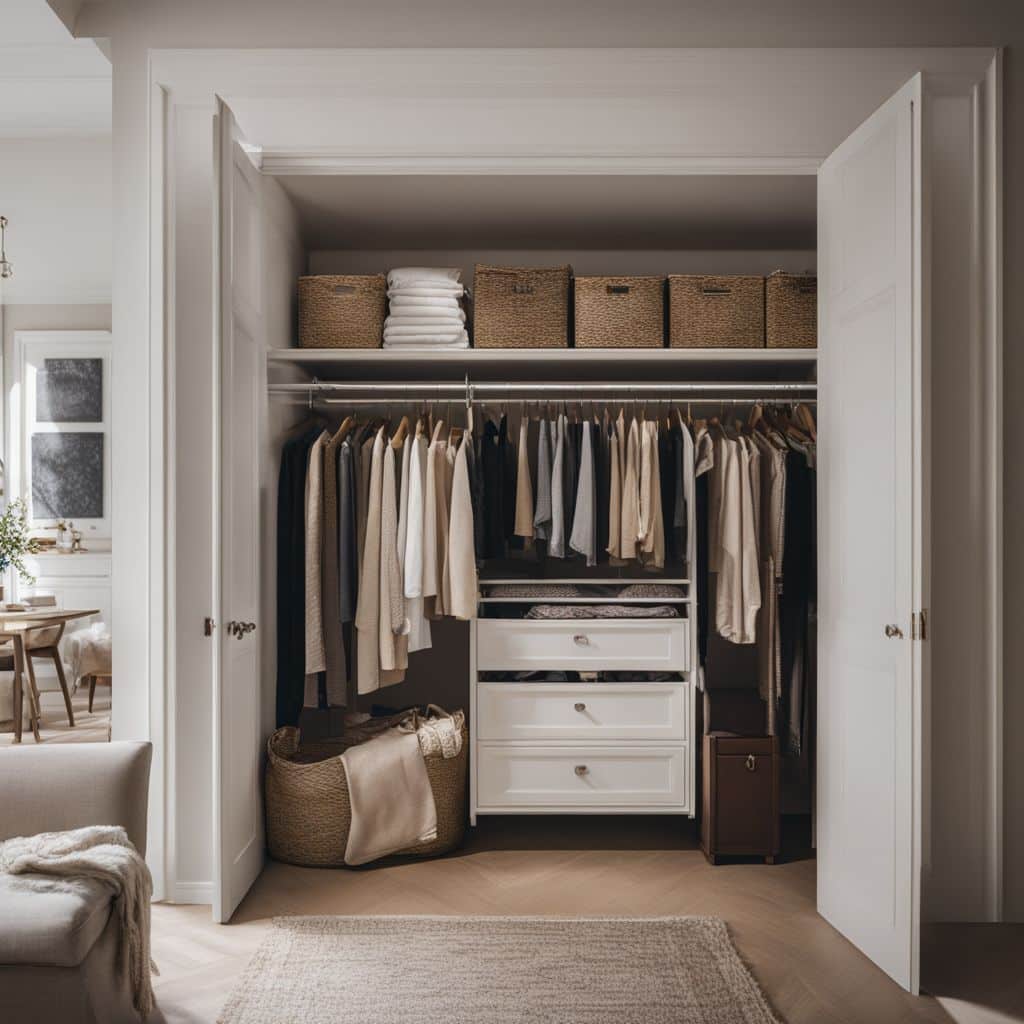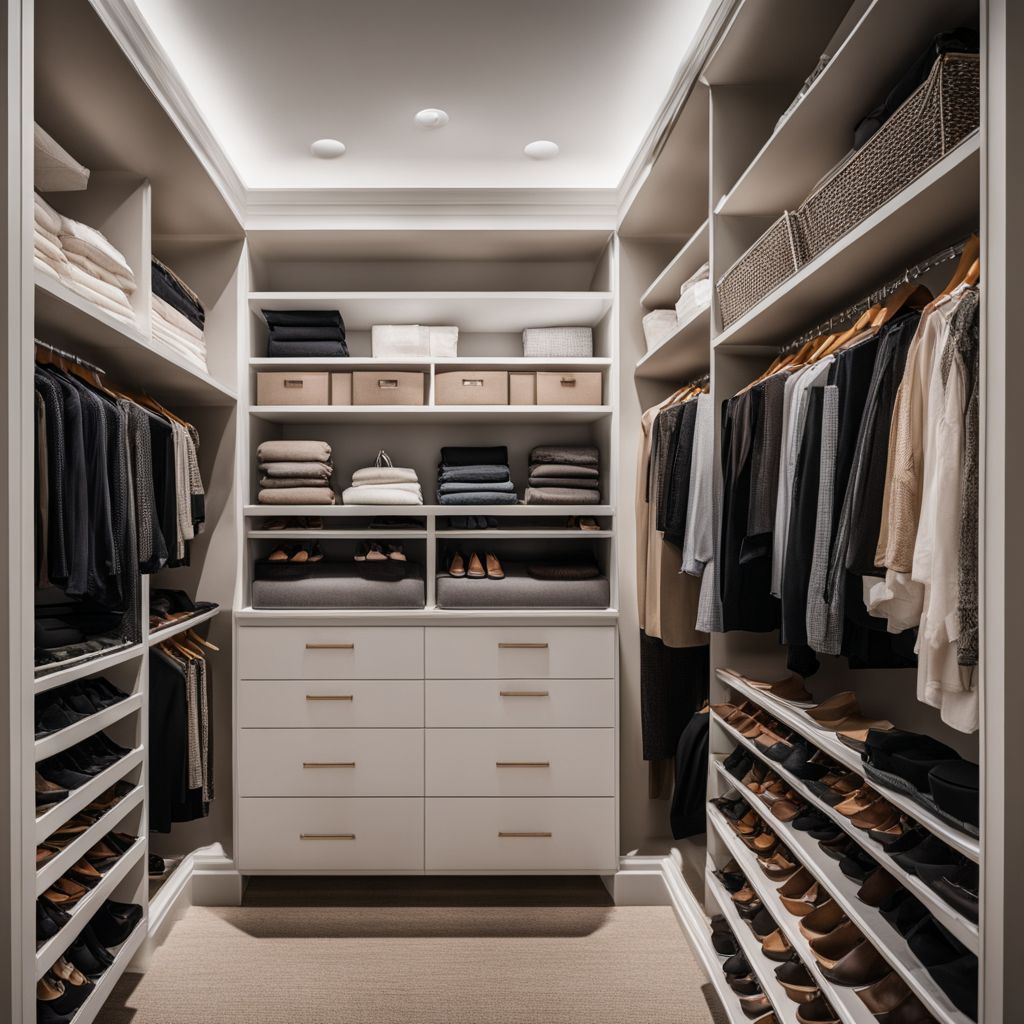Are you struggling to figure out the perfect size for your bedroom closet? It’s a common dilemma faced by many when designing their ideal space. Our guide will provide you with standard dimensions and tailored strategies to efficiently maximize your storage needs.
Dive in to transform your cluttered closet into an organized oasis!
Related: 9 Best Alternatives to Folding Closet Doors (With Pictures)
Standard Closet Dimensions and Measurements

The standard dimensions for reach-in closets typically range from 3 to 8 feet wide, with a depth of 24-30 inches. Walk-in closets should be at least 4×4 feet, but the size can vary based on available space and individual needs.
Pull-out drawers and shelves usually have a standard depth of 24 inches, while hanging rods are typically around 20 inches in length.

Reach-in closets (3 to 8 ft wide, 24-30 in depth)
Reach-in closets are the go-to for many bedrooms because they fit well in most spaces. These closets range from 3 to 8 feet wide, perfect for a variety of layouts. With a standard depth of 24 inches, you’ll have enough room to store clothes and necessities without taking up too much space in your bedroom.
To get the most out of this type of closet, think about adding adjustable shelving or double hanging rods. This way, you can use every inch wisely and keep everything easy to find.
Whether it’s shirts up high or shoes down low, make sure there’s a spot for all your items in these cozy storage areas.
Walk-in closets (at least 4×4 ft, but can vary)
Walk-in closets give you more room to move and store things. They need to be at least 4×4 feet, but the size can change depending on your house and what you want. Bigger walk-in closets might be 5 feet by 5 feet or even larger.
This gives you plenty of space for clothes, shoes, and other items. With a big closet, you can walk inside and see everything easily.
You can fit lots of storage units in walk-in closets like shelves for shirts or racks for shoes. If your closet is at least 7 to 10 feet wide, it could have two sets of shelves facing each other.
This lets you organize your stuff better so you can find everything fast. A good-sized walk-in closet makes getting ready in the morning quicker because all your things are right there where you can see them.
Pull-out drawers and shelves (standard depth of 24 in)
Pull-out drawers and shelves are a great option for keeping your closet organized. They slide out easily, giving you clear views and easy access to your items. With a standard depth of 24 inches, they provide enough space to store bulky items like sweaters or jeans without crushing them.
Think of these storage solutions as the secret weapon in maintaining an orderly closet.
Having enough space helps you keep things tidy. Hanging rods are another key part of your closet setup, so let’s look at their role in creating an efficient storage area.
Hanging rods (20 in in length)
When it comes to hanging rods, it’s important to consider the height and placement. For single-rod closets, typically allow about 66 inches of vertical space from the floor. Long-hang rods are placed higher, around 64-68 inches above the floor for items such as gowns and overcoats.
Upper hanging rods should ideally be positioned between 72-82 inches high on vertical walls while short hanging rods work best at 30-40 inches off the floor. These measurements ensure efficient use of space and easy access to your clothes.
Longer garments like gowns or coats necessitate different rod heights than shorter clothing articles. By placing upper hanging rods higher up on walls and lower ones closer to the ground, you optimize storage while maintaining accessibility for all your wardrobe essentials without wasting any space.
Factors to Consider When Designing Your Closet

Consider the size and layout of your room, your storage needs, available space, and budget when designing your closet. For more detailed tips and best practices, keep reading to create the perfect bedroom closet for you.

The size and layout of your room
Consider the size and layout of your room when planning your closet. A small room might benefit from a reach-in closet, while a larger room could accommodate a spacious walk-in closet.
The dimensions and design should blend seamlessly with the space available in your bedroom, ensuring a practical and efficient use of square footage.
To maximize storage potential, remember to factor in the specific needs of your living area. Whether it’s an apartment or a spacious home, the right closet layout can enhance functionality and aesthetics.
Your storage needs and preferences
When considering your storage needs and preferences, it’s important to take into account the dimensions of your clothes. Custom closet design rules should be followed to create an efficient and organized space for your storage requirements while considering ergonomics to ensure easy access.
Additionally, assess your closet space and the layout of your current closet when planning a new custom design. By incorporating these considerations, you can optimize the functionality of your closet based on specific requirements and maximize its potential for storing seasonal items or everyday essentials.
Available space for your closet
When planning your closet, the available space is a crucial aspect to consider. The size of your room and the layout will dictate the potential dimensions for your closet. Whether it’s a small reach-in or a spacious walk-in, understanding the square footage and floor plan will help in determining the right size and maximizing storage potential within your given space.
Consideration should also be given to any additional storage needs, such as hanging rods and pull-out drawers, along with budget constraints. Utilizing every inch thoughtfully can make even a smaller space more functional while ensuring that larger walk-in closets are not overcrowded.
By taking these factors into account, you can design an efficient and well-organized closet tailored to your specific requirements.
Budget and materials
When designing your closet, it’s important to consider your budget and the materials you’ll need. Custom closets can be more expensive but offer tailored solutions for maximizing storage space.
Keep in mind that pre-fabricated closet systems are usually more cost-effective and come with a variety of material options such as wood, wire, or laminate. Knowing your budget constraints and preferred materials will guide you in making informed decisions about the design and functionality of your bedroom closet.
Once you have established your budget and chosen the materials, take advantage of practical tips for getting the most out of your investment. Opt for durable yet affordable materials to ensure longevity without overspending.
Tips for Maximizing Your Closet Storage Potential
– Use vertical space by installing stackable shelves to make the most of your closet’s height.
– Utilize the back of your closet door with hooks or organizers for additional storage options.
– Invest in storage organizers such as bins, baskets, and dividers to keep everything neatly organized.
– Regularly declutter and organize your closet to ensure you’re maximizing the available space efficiently.

Use vertical space with stackable shelves
Maximize your closet space by using stackable shelves that make the most of your vertical space. Stackable shelves allow you to efficiently use the height of your closet, creating more room for folded clothes, shoes, and other items.
By stacking shelves from floor to ceiling, you can increase storage capacity without taking up additional floor space.
Additionally, utilizing stackable shelves not only provides ample storage but also helps in keeping your items organized and easily accessible. This solution is particularly beneficial for small closets or walk-in closets with limited floor area as it allows you to store more without cluttering the available space.
Embrace the potential of vertical storage with stackable shelves to optimize every inch of your closet while maintaining a neat and functional layout.
Utilize the back of your closet door
Maximize your closet space by using the back of the door for extra storage. Add hooks, shelves, or organizers to keep items easily accessible and organized. By utilizing this often overlooked space, you can create more room for your belongings without taking up valuable floor or shelf space.
Embrace the potential of the back of your closet door to make the most out of your storage solutions and keep everything in its place.
Create additional storage on the back of your closet door with hooks, shelves, or organizers. This simple yet effective solution helps maximize space and keeps frequently used items within easy reach.
Invest in storage organizers
To fully maximize the potential of your closet, investing in storage organizers is essential. Thinner hangers and smart shelving can help save space and keep your items organized. Also, consulting with professional organizers can provide valuable insights into finding the best tools for organizing messy closets of any size.
Researching various organization techniques will ensure you have the most efficient solutions tailored to your specific needs.
Consider using pull-out drawers, stackable shelves, and hanging shoe racks to make use of every inch of available space within your closet. This proactive approach not only helps declutter but also makes it easier to maintain an organized and functional storage area for all your belongings while saving time and effort in the long run.
Declutter and organize regularly
To fully optimize the storage potential of your closet, it’s crucial to declutter and organize regularly. Regular decluttering not only reduces clutter but also helps you identify items you no longer need, creating more space for the things you actually use.
By sorting through your clothes and accessories on a regular basis, you can keep your wardrobe organized and ensure that everything has its designated place. Notably, taking the time to declutter will prevent unnecessary accumulation of items, making it easier to find what you need when getting dressed each day.
Regular organization is essential in maintaining an efficient closet space. When everything is in its proper place, finding specific items becomes much easier, saving time during your daily routine.
Conclusion and Final Thoughts
In summary, this comprehensive guide offers essential information to help you plan and design your bedroom closet efficiently. By following the standard dimensions and best practices provided, you can maximize storage space while staying within budget.
From reach-in to walk-in closets, incorporating these tips will help you make the most of your available space and create a well-organized storage solution for your home. Whether it’s utilizing vertical space or investing in storage organizers, implementing these strategies will ensure that your closet meets your specific needs effectively.
Take advantage of the expert advice and put these actionable tips into practice when designing or revamping your bedroom closet.